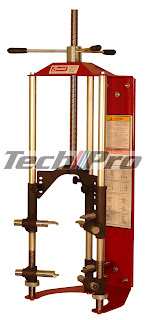On the off chance that you anticipate
revamping the motor in that old authority auto or truck of yours, there is one
strength instrument that you will absolutely require: a valve spring
compressor. Without this particularly planned device, it will be for all
intents and purposes inconceivable for you to expel the valves from the barrel
head. With a specific end goal to expel the admission and fumes valves, the shop
spring compressor that holds every valve set up must be packed. Once the spring
is lessened in stature (which is typically just around 3/sixteenth of an inch),
the two-piece neckline (frequently alluded to as guardians) that fits around
the notch encompassing the highest point of the valve stem can be discharged,
the spring retainer lifted off and the valve expelled from the chamber head by
sliding it down the valve manage.
It's an exceptionally basic process;
however without a shop
spring compressor / equipment, unless you're Superman, you won't have the
capacity to do it. The most widely recognized sort of valve spring compressor
is the manual U-molded compressor. This apparatus is completely customizable in
it’s achieve so it can fit over an assortment of barrel heads, and has flexible
forks so it can be custom-made to fit an assortment of valve spring
measurements. The main drawback to this kind of compressor is that the chamber
head must be expelled from the motor. The normal cost for one is around $40; be
that as it may, at a current Carlisle swap meet, the frequently observed
apparatus merchant close to the sustenance court was offering no-name.
Truth be told, so powerful is this
instrument it took me around 20 minutes to expel the eight valves from my
Triumph's barrel head. For around $7, you can buy from your nearby car parts
store a straightforward valve spring compressor fork that depends on the
support technique for discharging the springs' strain. Made of thick, squeezed
sheet-metal, the 12-inch-long fork turns on one of the bordering rocker shaft
studs, where it is held in position by a solitary nut that screws onto the
stud. By pulling the fork towards you, the contrary end presses the valve
spring down, enabling you to evacuate the two managers holding the spring set
up. This sort of hardware requires far more prominent exertion than the
beforehand said compressor, so it can be somewhat hard to utilize, particularly
with stiffer, rivalry write springs or on double spring setups. The other
disadvantage is that the fork's opening on the valve spring end is
non-customizable, making it difficult to use on little dislodging motors that
utilization little measurement springs, yet it works fine and dandy.














0 comments:
Post a Comment